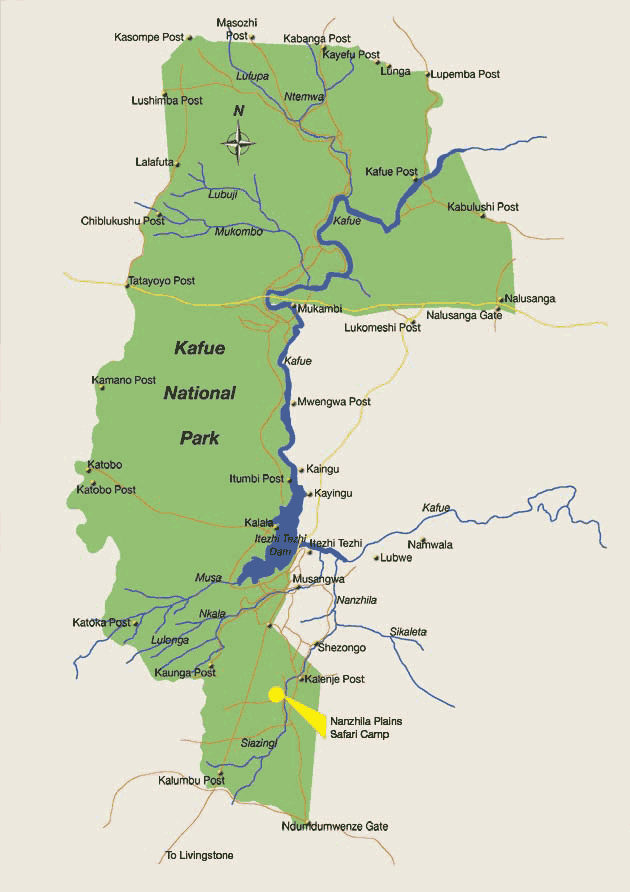Kafue National Park
Community Employment
Namwala Tourism
Namwala GMA

Namwala Game Management Area
The Namwala GMA comprises 3,600 km2. GMA’s play a vital role acting as a buffer zone in an ecological capacity, mitigating the negative effects of human activities in Kafue National Park.

Kafue National Park
The Kafue National Park is among the top five wildlife parks in the world, the third largest in Africa and certainly the largest in Zambia. The park lies adjacent to the Namwala GMA and Namwala District.

The KNP encompasses an area of 2.25 million hectares, home to 79% of Zambia’s mammal species and 80% of Zambia’s birdlife species. The Kafue National Park is named after the Kafue River that dissects it from the north to the south of the park where it feeds into the man made Itezhi Tezhi dam created in the late 70’s.


Birdlife in KNP and Namwala District
The Kafue National Park and Namwala district is renowned for its 500 species of birdlife, boasting some of the richest birdlife in all of Zambia. The Busanga Plains with its rich luscious grasses are home to one of the rare known breeding sites of the endangered wattle cranes. The range of birds cover breeds of herons, storks and ibises, Denham's (or Stanley's) and Kori bustards, secretary birds, and geese (spur-winged and Egyptian) by the thousand.



Endangered Species
The bird population in the Busanga plains includes the endangered wattled cranes. The Kafue National Park is also known to hold the largest population of the African Wild Dog compared to any other park in Africa. Sadly, there are no longer any rhinos left in the Kafue National Park due to poaching.
In the late 1960’s the elephant population of the KNP numbered a herd of 60,000, but today estimates run at just over 4,000.
Due to the proximity of the Kafue National Park and Namwala District, the Namwala Cultural and Traditional Trust NACTT and Namwala LIWI are committed to having integrated Livestock and Wildlife Health Management training and awareness.
Wildlife act as reservoir hosts for many pathogens for diseases such as bovine tuberculosis, brucellosis, and tick borne diseases. This results in complex epidemiology between wildlife, livestock and human populations.
Tourism
NACTT recognizes that while it is important for the Namwala Region to promote and encourage tourism the overlying ambition is to ensure considerate eco-tourism methods.
NACTT invites Eco-Tourism ventures offering experience with wildlife and culture in an untouched ecosystem.
NACTT believes in the potential to showcase Namwala District’s wealth of biodiversity through tourism. The Namwala rural community lacks capacity and resources to benefit from the positive natural areas in the district.
To counter-act resource-extractive economic activities, such as poaching, NACTT seeks to create cultural and eco-tourism opportunities of sustainable tourism.
NACTT’s tourism potential key areas:
-
Namwala Fishing Lodge
-
Eco-Resort Blili Hot Springs
-
Cultural Village and Tours
-
Traditional Ceremonies
-
Namwala GMA Eco Lodges


Community employment
NACTT is building capacity in the region with well trained and competent workforce of local indigenous members equipped with the knowledge of livestock with integrated wildlife management.
The NACTT alumni will be available to work for the Zambia Wildlife Authority and other private entities in the capacity of tour guides, wildlife security, beef farms, veterinary officers and cultural center staff.
Animals found in Kafue National Park
The parks beauty is mainly about the sheer diversity of wildlife. Home to the highest variety of animals boasting 158 recorded species of mammals and 500 recorded species of birds (roughly as much as the whole of Europe) the KNP is one of the last pristine wilderness on the planet.
Mammals in the park include rare antelope such as blue and yellow backed duiker, sitatunga, lechwe, roan and sable, and hartebeest. Buffalo, lion and red lechwe roam freely across their natural habitat. Leopards, the elusive predators may be often sighted as well as the rare cheetah.
The Kafue River itself holds abundant activities of hippo and some of the largest crocodiles in Africa.
The 158 species of animals found on the verdant grasslands of the Kafue National Park represent 70% of Zambia’s various mammals. From rare antelope to abundant herds of puku these magnificent animals strut and roam in their natural habitat in complete harmony with their environment.





The ecology of Kafue National Park and Namwala District
The predominant landscape of the Kafue National Park is made up of an undulating mosaic of miombo woodland and dambos showing a picturesque sight when seen from the air. Munga woodland and riparian forest make a pretty backdrop as they border the banks of the Kafue river. Throughout the swamps can be found tree islands with succulent sycamore fig trees.
The northern park of Kafue has more rainfall than any other part of the park which has brought about richer thicker and taller vegetation. These woodlands are dominated by large leafed Munondo trees, ‘Prince of Wales Feathers’, and Mobola plum trees.
In the southern area of the Kafue National Park experiences lower rainfall thus Kalahari sand soils in this drier ecosystem. Beautiful teak forests grow side by side with silver lea Terminalia, poison pod albizzia and luscious groves of cathedral mopane trees.
On the far south side of the park lie the Nanzhila Plains, graced with beautiful wide grasslands and towering baobabs with jackelberry trees sprouting from them.
